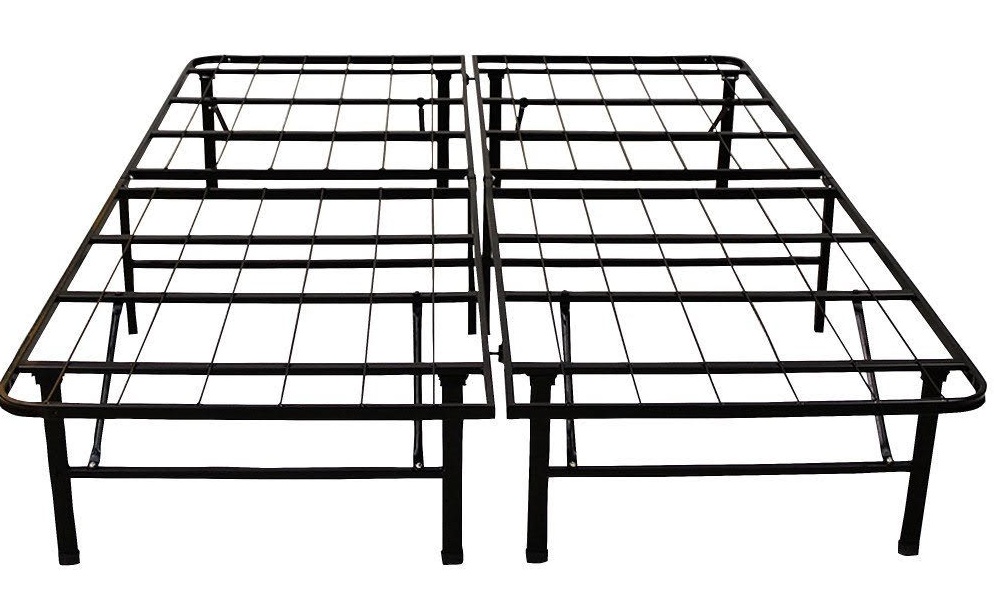
Water | Swimming Pools
DIY Toxic Free Pet Bed
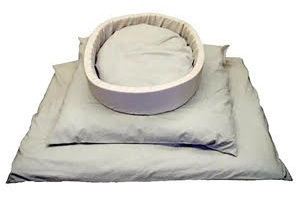
Here’s an organic pet bed for dogs and cats, sold in the USA at Only Natural Pet
Question from Kimberley
Hi Debra,
I have just came across your website and love all your reviews and info on non toxic products!
I am specifically looking for an all natural dog bed for my new puppy and wondered if you had any UK supplier suggestions? I noticed you offered a US company, but I would love to find one closer to home. I’m also happy to do a DIY dog bed if you have any suggestions on this?
I’m not sure you do requests like this, but I thought I’d give it a go on the off chance.
Thanks so much for your time.
Debra’s Answer
I love the UK and would be happy to come there and find all your nontoxic products, but at the moment mu knowledge is limited to the USA.
But since you are willing to make your own, here are my suggestions.
A pet bed is basically a big pillow that you fill with something. So to make a natural pet bed, just use natural materials.
For the cover, choose GOTS certified organic cotton if you can get it. Otherwise any cotton fabric you like that does not have a permanent press finish. Something like a good sturdy canvas would be a good choice.
Here’s a useful post called What Material Is Good to Fill a Dog Bed? . They suggest
- Foam – so I would go with GOLS certified organic latex foam
- Cedar Chips – these smell nice and also repel bugs naturally.
- Old Clothes – my favorite because you can take them out and wash them and wash the cover too and it will be clean, clean, clean.
Take a look at a commercial pet bed made with synthetic materials for design ideas, then make what you like with natural materials.
The Felt Company
 All kinds of felt fabrics, from straight-off-the-sheep wool to dyed wool felt in many colors. Also polyester and recycled felt, so read descriptions carefully.
All kinds of felt fabrics, from straight-off-the-sheep wool to dyed wool felt in many colors. Also polyester and recycled felt, so read descriptions carefully.
Linen Dreams
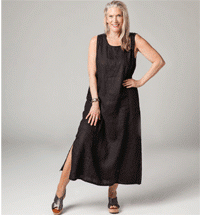 Nightwear for women made mostly of linen, some items made of cotton. Loose-fitting simple designs can be worn to bed or around the house, some even are appropriate to wear elsewhere. Some colors and patterns. Affordable prices for linen.
Nightwear for women made mostly of linen, some items made of cotton. Loose-fitting simple designs can be worn to bed or around the house, some even are appropriate to wear elsewhere. Some colors and patterns. Affordable prices for linen.
4 Legger
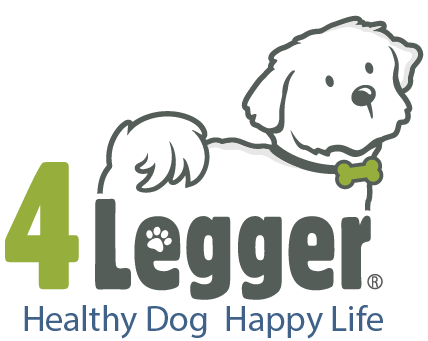 Dog shampoo certified to USDA organic food standards. “We aren’t your typical dog shampoo company. We’re safer and better because for us it is personal. We’re on a mission to change an industry by reducing toxins in pet grooming products and educating pet parents so they can enjoy the company of their best friends for years and years! ”
Dog shampoo certified to USDA organic food standards. “We aren’t your typical dog shampoo company. We’re safer and better because for us it is personal. We’re on a mission to change an industry by reducing toxins in pet grooming products and educating pet parents so they can enjoy the company of their best friends for years and years! ”
Armstrong’s All Natural
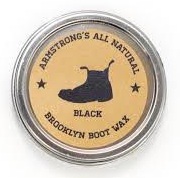 All natural leather care products, including boot wax, boot shine, leather conditioner, leather wax and saddle soap, plus genuine natural wood and horsehair buffing brushes. “ARMSTRONG’S ALL NATURAL products are handmade in small batches in New York, USA. Our mission is to refocus American manufacturing by locally sourcing pure, natural ingredients that support sustainable farming practices in order to produce the highest quality handcrafted, artisanal products possible. We use minimal, high-recyclable-content packaging and we have essentially zero waste. Since we do not use synthetic chemicals, any “waste” is diverted to our garden or compost system, if not recycled. We use certified organic ingredients whenever possible.” Also other interesting leather products and accessories.
All natural leather care products, including boot wax, boot shine, leather conditioner, leather wax and saddle soap, plus genuine natural wood and horsehair buffing brushes. “ARMSTRONG’S ALL NATURAL products are handmade in small batches in New York, USA. Our mission is to refocus American manufacturing by locally sourcing pure, natural ingredients that support sustainable farming practices in order to produce the highest quality handcrafted, artisanal products possible. We use minimal, high-recyclable-content packaging and we have essentially zero waste. Since we do not use synthetic chemicals, any “waste” is diverted to our garden or compost system, if not recycled. We use certified organic ingredients whenever possible.” Also other interesting leather products and accessories.
California Coast Naturals
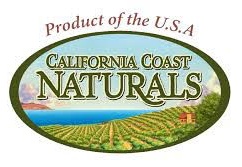 California grown, certified organic black and green olives and olive oil—hand-picked and hand-packed. Plain, stuffed, and flavored (sweet balsamic sundried olives, anyone?). Their Sun Dried Black Olives are the very olives used in the famous Black Olive Brittle & Goat Cheese Ice Cream featured at Salt and Straw.
California grown, certified organic black and green olives and olive oil—hand-picked and hand-packed. Plain, stuffed, and flavored (sweet balsamic sundried olives, anyone?). Their Sun Dried Black Olives are the very olives used in the famous Black Olive Brittle & Goat Cheese Ice Cream featured at Salt and Straw.
Millions Now Known To Have Multiple Chemical Sensitive (MCS)

Anne Steinemann PhD has been a leading researcher studying the health effects of fragrance in consumer products for many years.
Her latest study assesses the prevalence of multiple chemical sensitivities (MCS), its co-occurrence with asthma and fragrance sensitivity, and effects from exposure to fragranced consumer products.
She concluded that the prevalence of diagnosed MCS has increased over 300%, and self-reported chemical sensitivity over 200%, in the past decade. She recommended implementation of fragrance-free policies to reduce adverse health and societal effects.
Results of this study provide evidence that MCS is widespread and increasing in the US population: an estimated 25.6 million adults are diagnosed with MCS, and an estimated 51.8 million adults report chemical sensitivity. Using the same criteria to assess MCS and chemical sensitivity as prior US national prevalence studies, this represents an increase of 300% in diagnosed MCS and 200% in self-reported chemical sensitivity in a little more than 10 years.
In addition, among individuals with MCS, 86.2% report adverse health effects from exposure to fragranced consumer products. Thus, individuals with MCS are proportionally more likely to be fragrance sensitive than individuals without MCS (prevalence odds ratio 16.8; 95% confidence interval 10.3 to 27.5).
As a consequence, individuals with MCS are prevented from accessing restrooms, businesses, workplaces, and public places due to risk of adverse health effects—some potentially disabling—from fragranced consumer products. Notably, exposure to fragranced consumer products is associated with lost workdays or a job, in the past year, for 11.0% of the adult population with MCS or chemical sensitivity, representing an estimated 22 million Americans. While researchers continue to investigate which chemicals or mixtures of chemicals in fragranced consumer products could be associated with adverse effects,18 a practical step in the meantime would be to reduce exposure to the products. For instance, 71.0% of those with MCS would support fragrance-free policies in the workplace, and 82.1% would prefer fragrance-free health care facilities and professionals, as would a majority of the US general population.
You can read other articles on the health effects of frangraced consumer products on Dr Steinneman’s website.
including:
Fragranced consumer products and health effects in America
Air fresheners and indoor air quality
Felted Wool Shepardess Jacket
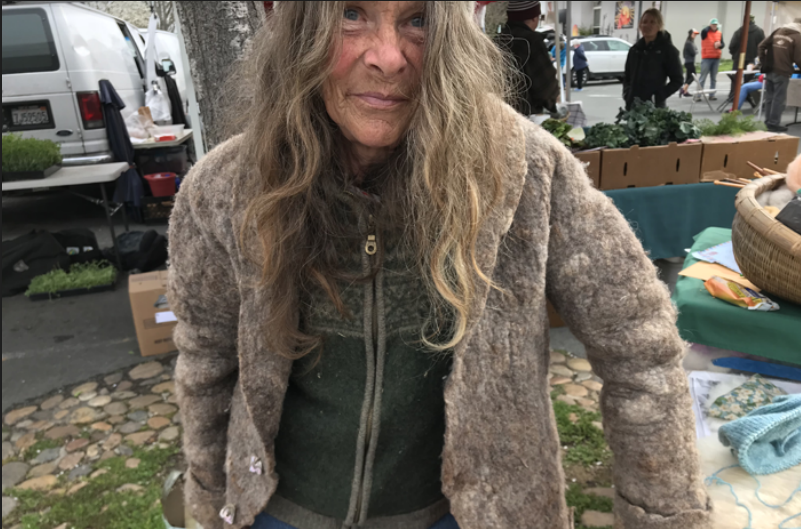
Shepardess Hazel Flett of Bodega Pastures wearing her fleece wool jacket at the Sebastopol Farm Market, handmade from the wool from her sheep.
It’s been cold here in California this week. Cold and rain and more to come.
So one of my favorite vendors at the Sebastopol Farm Market—where Larry and I go every Sunday morning—was wearing her felted wool jacket.
“Stay warm!” I said as we walked by and waved to Hazel.
“I am,” she replied. “The wind doesn’t go through my felted wool jacket.”
Felted wool jacket?!?!?!?!??!?!!
Years ago my friend Eliana, who founded Shepherd’s Dream introduced me to felting. She made a queen-sized felt for my bed and I’ve been sleeping on it since. She now makes whole “mattresses” from layers of wool felts at Heartfelt Collective. When I got my felt for my bed, my first thought was, “I want a felt coat!”
Felting is a process of making a sort of fabric from wet wool, where the coil-like wood fibers wrap around each other.
Hazel’s jacket is made of wool from her own sheep, so it contains all the colors of their wool.
She also pointed out that there are no seams because the entire jacket is pieced together by felting.
Of course, one can’t buy a felted jacket. I have to wait until the woman who teaches felting gives the felted jacket workshop again and then one need’s to felt one’s own, specific to one’s own body.
And of course, I will be at this workshop.
THIS is what we should be wearing.
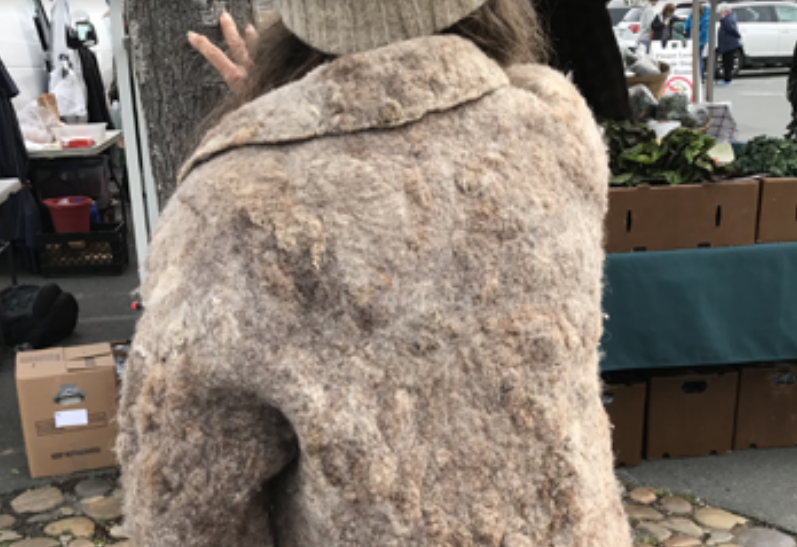 |
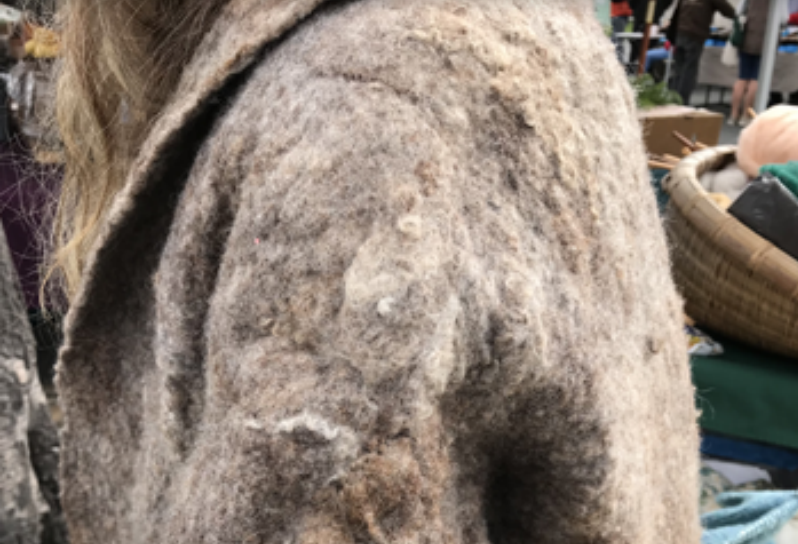 |
* * * * *
Now all that said, I DID find two felted (aka “boiled”) wool coats online. Don’t know anything about them except what’s in the descriptions, so if you explore these, please leave comments.
Peruvian Connection Halden Alpaca Felted Coat
Peruvian Connection Tuileries Baby Alpace Reversible Coat. This one is more like what I think of as a perfect coat—like a big blanket with arms.
Continuing to search I see that there are many coats that come up as “boiled wool” or “felted wool” but then the jacket is made with polyester linings, etc. The above were the only three I could find that were 100% unlined wool.
Good Box Spring
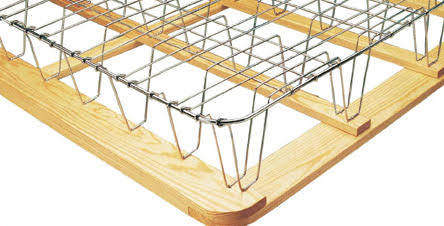
Question from Nick
Hi Debra,
Wanted to know if you know a good non toxic healthy box spring or foundation for under a mattress?
Debra’s Answer
Actually I had never thought about this before.
I bought a wood slat frame for my natural mattress years ago and I think most people do that. These are widely available. The least expensive are those from IKEA, which I have purchased in the past and recommended to readers and clients. Nobody has ever complained to me they didn’t like them. But there are many others. Get unfinished wood and leave unfinished or apply a toxic free finish.
You can also get metal bed frames, also many available online. If you have a spring mattress you can put it right on the metal bed frame. For those of you with futon-type mattresses, you’ll need to get a “bunkie board” which is just the wood slats that you can put in any metal bed frame. Here’s one made of solid wood slats . Read descriptions carefully as some are made from glue laminated wood strips.
I had an assumption that all the natural mattress manufacturers would make box springs, but apparently they don’t.
Here are some box springs made with organic and natural materials:
Here is a very basic metal frame that can be used alone or fit into any bed frame
Classic Brands Hercules Heavy-Duty 14-inch Platform Metal Bed Frame
Allbird Shoes
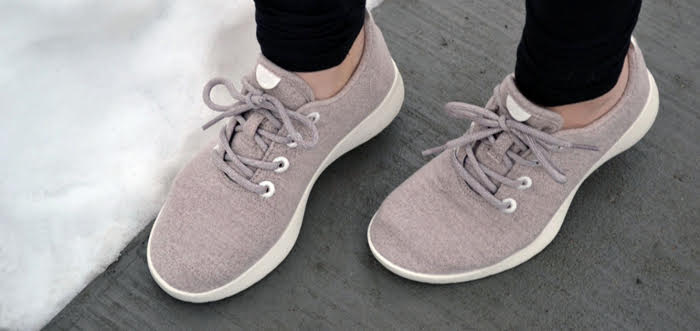
Allbirds advertises their shoes as “wool” but it’s really a proprietary fiber made from wool and undisclosed ingredients.
Question from Heather
Hi Debra,
I am wondering about Allbird shoes and your thoughts? I am desperately trying to find shoes for my kids and elements age boys in Seattle need good shoes. I love Pololo but only found one place in USA that sells them and sizes are slim. What are your thoughts?
Debra’s Answer
First, I see that in addition to this question, you also made some other comments, including that Campers have polyester and polyurethane in them.
As you have found, it’s very difficult to find shoes that are 100% natural and even if you find them, they are often not available or affordable.
Given the state of the market today, some product categories are better than others with regard to having toxic free products available.
Shoes are one of those categories.
You commented specifically that Campers have polyurethane and polyester. Not sure where the polyester is, but I believe the soles are polyurethane. I have a pair of Campers and I wear them almost everyday. I’ve actually been wearing Campers for years and have never had a problem with the release of any kind of odor from these shoes.
In terms of toxic materials used in shoes, I personally will accept polyester and polurethane in a vegetable-tanned shoe rather than wear a pair of shoes made with PVC or chemical-tanned leather which are much more toxic.
But you asked me about Allbirds.
Looking at their website I see that they have shoes made from “Wool” and other shoes made from “Tree.”
On their FAQ page they state that their “Wool” is “proprietary merino fabric…” Proprietary wool fabric. This sounds like wool mixed with some other material. And they are not going to tell you what it is. So it’s not 100% wool. And no information on chemicals that might be used in the raising of the sheep.
Their “Tree’ fiber is TENCEL(tm), a manmade fiber that is made from plant cellulose—in this case from trees—mixed with chemicals. The trees are from responsibly managed forests, but your body doesn’t recognize Tencel as a natural fiber because it isn’t.
So basically you have a company that is making shoes out of wool and tree turned into industrial fibers and marketing them as natural.
On their basic page about the shoe materials they state:
- their laces are 100% recycled polyester.
- insoles are their proprietary merino wool fabric (with undisclosed ingredients)
- the sole is “proprietary low-density foam” (again undisclosed ingredients). It’s pretty likely it’s polyurethane foam. I’m not concerned about the polyurethane, I’m concerned about the chemicals that are used to make it into foam.
I prefer Campers.

